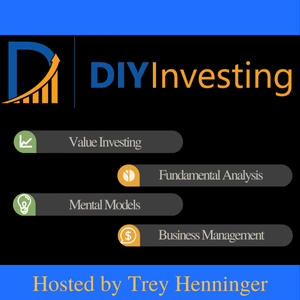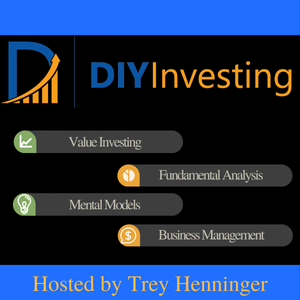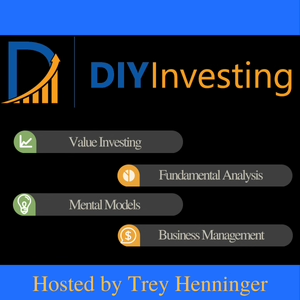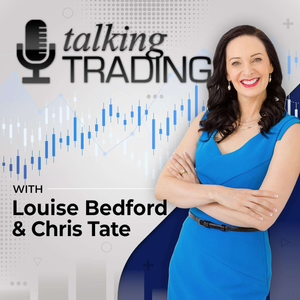
84 - Would you buy your employer's stock?
07/19/20 • 22 min
- Scuttlebutt
- Circle of Competence
If you enjoyed this podcast and found it helpful, please consider leaving me a rating and review. Your feedback helps me to improve the podcast and grow the show's audience.
Follow me on Twitter and YouTubeTwitter Handle: @TreyHenninger
YouTube Channel: DIY Investing
Support the Podcast on PatreonThis is a podcast supported by listeners like you. If you’d like to support this podcast and help me to continue creating great investing content, please consider becoming a Patron at DIYInvesting.org/Patron.
You can find out more information by listening to episode 11 of this podcast.
Show OutlineThe full show notes for this episode are available at https://www.diyinvesting.org/Episode84
Scuttlebutt Challenge: Your Employer's Stock- If your company isn’t public, assess it qualitatively or do this work on your spouse's company or where a friend works.
- If you work for a non-profit or government, do the same.
- Email me your write-up during the month of July 2020 and I'll send you a response.
- Assess the industry
- Assess your company’s place in the industry
- What is the culture of your company like?
- What is the priority of management? Are they shareholder friendly? Are they employee-friendly? Other concerns?
- How are capital allocation decisions made?
- How are CapEx decisions made?
- Does your company earn high returns on capital?
- Does it use leverage?
- In summary: Is it a high-quality business?
- What are the risks?
- How would you value your employer’s stock? (Write down an explicit intrinsic value)
The company you work for should be the first place you look to begin understanding how to perform scuttlebutt. Investors should analyze their employer's stock as a potential investment candidate. Culture, Quality, and Management are key areas.
- Scuttlebutt
- Circle of Competence
If you enjoyed this podcast and found it helpful, please consider leaving me a rating and review. Your feedback helps me to improve the podcast and grow the show's audience.
Follow me on Twitter and YouTubeTwitter Handle: @TreyHenninger
YouTube Channel: DIY Investing
Support the Podcast on PatreonThis is a podcast supported by listeners like you. If you’d like to support this podcast and help me to continue creating great investing content, please consider becoming a Patron at DIYInvesting.org/Patron.
You can find out more information by listening to episode 11 of this podcast.
Show OutlineThe full show notes for this episode are available at https://www.diyinvesting.org/Episode84
Scuttlebutt Challenge: Your Employer's Stock- If your company isn’t public, assess it qualitatively or do this work on your spouse's company or where a friend works.
- If you work for a non-profit or government, do the same.
- Email me your write-up during the month of July 2020 and I'll send you a response.
- Assess the industry
- Assess your company’s place in the industry
- What is the culture of your company like?
- What is the priority of management? Are they shareholder friendly? Are they employee-friendly? Other concerns?
- How are capital allocation decisions made?
- How are CapEx decisions made?
- Does your company earn high returns on capital?
- Does it use leverage?
- In summary: Is it a high-quality business?
- What are the risks?
- How would you value your employer’s stock? (Write down an explicit intrinsic value)
The company you work for should be the first place you look to begin understanding how to perform scuttlebutt. Investors should analyze their employer's stock as a potential investment candidate. Culture, Quality, and Management are key areas.
Previous Episode

83 - Key Drawbacks of the Banking Industry
Mental Models discussed in this podcast:
- Commodity
- Leverage
- Availability Bias (re 2008 Financial Crisis)
If you enjoyed this podcast and found it helpful, please consider leaving me a rating and review. Your feedback helps me to improve the podcast and grow the show's audience.
Follow me on Twitter and YouTubeTwitter Handle: @TreyHenninger
YouTube Channel: DIY Investing
Support the Podcast on PatreonThis is a podcast supported by listeners like you. If you’d like to support this podcast and help me to continue creating great investing content, please consider becoming a Patron at DIYInvesting.org/Patron.
You can find out more information by listening to episode 11 of this podcast.
Show OutlineThe full show notes for this episode are available at https://www.diyinvesting.org/Episode83
Key Characteristics of the banking industry which make it unattractive for investors- 2008 Financial Crisis
- I could probably end this episode with that statement alone. However, there is value in expanding on what bank investors can learn from the 2008 financial crisis. Specifically, how that event may be repeated or rhyme in the future and how to avoid owning a bank that may be affected.
- Risk Management is primary - which is heavily influenced by management
- A poor management team can quickly ruin a good bank. This is a problem for investors because it requires evaluating management and understanding their ability and focus on managing risk.
- This is harder to do than you may expect because nearly all bank managers are going to pay at least lip service to risk management.
- Buffett once talked about wanting to own a business that could be run by an idiot because eventually, an idiot would run it. Unfortunately, this does not often apply to banks. Why? It will be more clear as we discuss further issues.
- Banks operate with high leverage
- In many industries, high leverage can be seen as a sign of risky decision making. With banking, leverage is a feature. High leverage is not only present across the board in the banking industry but is required in order to earn an adequate return. I covered why in episode 79 when we discussed the banking business model.
- The more leverage a company uses the higher risk of blowing up or bankruptcy due to deteriorating loan performance. This is why management plans such a big role. It is easy to grow a bank by offering loans to people and companies that are not creditworthy. However, doing so sets up failure down the road.
- Leverage = Double-edged sword. Required for adequate returns, but the potential source of bankruptcy. 2008 was a prime example of how this could occur.
- Value Traps abound -> History of low returns, especially among small banks
- While high returning banks that are able to reinvest capital into growth offer great opportunities, there are many more banks that could be a value trap.
- Small community banks often trade below book value which can appeal to value investors. Yet, you’ll find thousands of banks like this which may have returns on equity below 10%. Any growth that these banks experience will lower an investor’s return instead of improving it.
- Time is not on your side if you select the wrong bank because they often don’t earn a high enough return.
- Why? Small towns especially have limited capital available to be stored in a bank. These towns are also heavily hit hard by the move towards online retail, urbanization, and loss of manufacturing jobs.
- Bankruptcy risk is higher than a normal industry
- While all companies can fail due to leverage, banks have more leverage than normal.
- While all companies can fail due to a liquidity trap, a bank’s entire business model is based on lending long-term and borrowing short-term.
- Remember, in episode 82, I talked about the benefit of fewer banks in the industry over time. That only exists because banks continue to fail and/or be bought out by larger competitors. This exemplifies that failure IS an option for many banks and requires a prudent investor.
- Money is a commodity and banks don’t control its price.
- The Federal Reserve in the United States makes a common practice of manipulating the value and price of money. They determine what short-term interest rate should be. There m...
Next Episode

85 - Precisely Wrong, Roughly Right (DCFs)
Mental Models discussed in this podcast:
- Discount Rates
- Gordon Growth Model
- Discounted Cash Flow Calculation
If you enjoyed this podcast and found it helpful, please consider leaving me a rating and review. Your feedback helps me to improve the podcast and grow the show's audience.
Follow me on Twitter and YouTubeTwitter Handle: @TreyHenninger
YouTube Channel: DIY Investing
Support the Podcast on PatreonThis is a podcast supported by listeners like you. If you’d like to support this podcast and help me to continue creating great investing content, please consider becoming a Patron at DIYInvesting.org/Patron.
You can find out more information by listening to episode 11 of this podcast.
Show OutlineThe full show notes for this episode are available at https://www.diyinvesting.org/Episode85
Why DCFs should not be used- What is a DCF?
- An estimate of all future cash flow (dividends or earnings) and discounted back to the present.
- When you add up these values you get the intrinsic value of a company.
- Gordon Growth Model (perpetual constant growth of a dividend - DCF)
- P = Div (next year’s) / (r-g)
- R = discount rate (10%)
- G = constant growth rate in perpetuity.
- Example:
- Dividend = $1.64 (Coca-Cola)
- Specific estimates: $27.85 (based on specific year estimates)
- Growth rate: 3% = $23.42 (equivalent to a 7% dividend yield)
- Growth rate: 5% = $32.80 (equivalent to a 5% dividend yield)
- Current price: approx. $46 per share
- Always invert.
- Dividend yield of 3.5% or growth rate of 6.5% in perpetuity.
- Example 2: P/E ratios for growing companies.
- I want to estimate how quickly I can reach a 10% earnings yield.
- I want it to be less than 5 years.
- Without compounding this means a 10% grower you can pay P/E of 15.
- A 20% grower you can pay P/E of 20.
- All of these imply you can sustain that growth for 5 years.
- Why ignore compounding? It’s simpler and conservative.
Discounted Cash Flow calculations and models provide precise estimates of intrinsic value but tend to be flawed. It is much better to improve accuracy by ignoring DCF and using a simple intrinsic value calculation like the Gordon Growth Model.
If you like this episode you’ll love
Episode Comments
Generate a badge
Get a badge for your website that links back to this episode
<a href="https://goodpods.com/podcasts/the-diy-investing-podcast-15422/84-would-you-buy-your-employers-stock-7347216"> <img src="https://storage.googleapis.com/goodpods-images-bucket/badges/generic-badge-1.svg" alt="listen to 84 - would you buy your employer's stock? on goodpods" style="width: 225px" /> </a>
Copy




